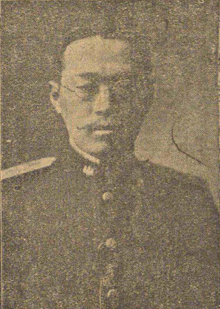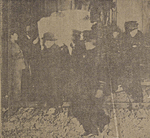Min Won-sik
Min Won-sik (Korean: 민원식; Hanja: 閔元植, July 12, 1886 – February 17, 1921) was a politician and journalist during the late Joseon Dynasty and the Japanese colonial era. He was an advocate for Korean political rights and autonomy. Also a noted writer and poet, he used the literary names of Chungam (정암, 正菴), Nankok (난곡, 蘭谷), Handong (한동, 韓東), and Yangha (양하, 養何).
Min Won-sik | |
|---|---|
 Min Won-sik, 1913 | |
| Born | July 12, 1886 Yangpyeong County, Gyeonggi, Korea |
| Died | February 17, 1921 (aged 34) Tokyo, Japan |
| Occupation | Korean politician and political rights of Korean activists and right of autonomy of Korean activists. |
He believed in the Japanese support of Korean interests. Until his death, he supported a system of Korean autonomy within the Japanese imperial system.
Biography
Under the Korean Empire
Min was born in the Yangpyeong County in Gyeonggi province. His real father was Min Young-jun, but he was adopted by a relative, Min Young-uk. His family belonged to the Yeoheung Min clan, a famous noble family of the Joseon Dynasty, and he was distantly related to Empress Myeongseong and Empress Sunmyeong. His wife was a niece of King Gogong.
In 1899, Min went to Japan to teach Korean language at the East Asia Foreign Language School (동아어학교). In February 1905, he returned to Korea and was appointed to a police post (Gyeongmucheong Chongsun (경무청 총순, 警務廳總巡), but he resigned after a year. Under the Japanese protectorate over Korea, he was rapidly promoted under the sponsorship of Ito Hirobumi and Hasegawa Yoshimichi, later becoming Secretary of the Ministry of Interior in July 1906, and Hygiene manager of the Bureau of Health and Sanitation within the Ministry of Interior in August 1906. As part of his efforts to improve the control of infectious diseases and hygiene in Korea, he introduced a system of state-regulated prostitution with mandatory testing for venereal disease.
In March 1907, he was appointed as acting director of a Gwangjewon hospital(광제원 廣濟院). From April 1 to 25, 1907, he was appointed as the director of Gwangjewon hospital, with a concurrent position as the Hygiene Department Director of the Ministry of Internal Affairs.
On January 1, 1910, he took office as CEO of The Newspaper Current Events (시사신문).[1] In 1910, he joined Club Jeongwu (정우회), a political club of Japanophilism.[2]
Under the Japanese general government
In 1910, after the Annexation of Korea by Japan, Min served on the Central Advisory Institute of the Governor-General of Korea. From the beginning of the Japanese period, Min argued for increased Korean autonomy and political rights within the Japanese Empire. In July 1911, he was appointed Governor of Yangji County, and in March 1914, he was appointed Governor of Icheon County. On several occasions, he petitioned the Japanese Governor-General for Korean suffrage, but his petitions were rejected. From 1915 to 1917, Min served as Commissioner of the Land Survey Committee of Gyeonggi Province, and in September 1917, he was appointed Governor of Goyang County. In 1919, he spoke out against the March 1st movement, believing that Korean independence at that time was impossible. He thought that the Korean independence movement only created needless violence and was detrimental to the cause of increased Korean autonomy, which he felt could be attained under the existing Japanese legal system.[3]
In November 1919, Min resigned as Governor of Goyang County, and he was immediately reappointed to the Central Advisory Institute of the Governor-General of Korea.
In July and November 1920, and again from January to February 1921, Min went to Japan to speak with lawmakers in the Diet of Japan, both in the House of Representatives of Japan and the House of Peers, to promote the cause of Korean autonomy. He stayed in Tokyo, and also met with other Japanese intellectuals.[4] However, Min's efforts to promote autonomy and better rights for Koreans under Japanese rule were strongly opposed by the Korean independence movement.
Death
On February 17, 1921, while Min was staying at the Imperial Hotel in Tokyo, he was stabbed with a dagger by Korean independence activist Yang Keun-hwan,[5] who was disguised as a carpenter. Min was taken to the Tokyo Imperial University hospital, but he later died of his wounds.

Min's coffin was moved by boat and train for the funeral service. After an hour-long service, his body was taken to Namdaemun. His entire funeral lasted for three days and was hosted by Eom Ju-myong (his brother in-law) and Eon Jun-won (his father in-law). His body was buried in neighboring hill of Hongreung.
After a few years, his grave was then moved to the temple compound of Gaeunsa, in the Anam-dong neighborhood of Seoul.
Work
Literature
- Matter of governing in Korea (조선 통치문제, 朝鮮統治問題), 1920
Works of art
- Muklando (묵란도 墨蘭圖)
- Mukmaedo (묵매도 墨梅圖)
- Mukjukdo (묵죽도 墨竹圖), 1914
- Kukhwa (국화 菊花)
References
- 밤의 일제 침략사 The Hangyoerye 2004-11-12. (in Korean)
- '친일파' 고희준 전 거제군수의 굴절된 삶 Ohmynews 2003-07-13. (in Korean)
- 김선흠 등 매일신보•시사평론 간부 8명 친일 규명 미디어오늘 2007-12-12 (in Korean)
- 총독부 드나들며 정보보고 후 기밀비 챙겨 오마이뉴스 2004-07-20. (in Korean)
- 5월의 독립운동가 양근환 선생 The Dongah 2009-05-01. (in Korean)
External links
- 민원식 (in Korean)
- Min Won-sik (in Korean)
- 김선흠 등 매일신보•시사평론 간부 8명 친일 규명 미디어오늘 2007-12-12 (in Korean)
- 국립병원, 일제의 유린을 받기 시작하다. [일제 강점기 의료의 풍경·8] 광제원 Pressian 2011-05-27. (in Korean)
- 조선 최초의 '보건복지부' 장관은? [근대 의료의 풍경·46] 근대 보건의료 개혁 Pressian 2010-08-05. (in Korean)